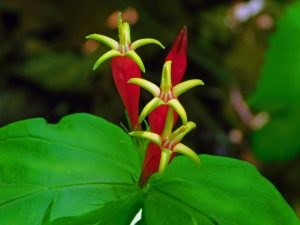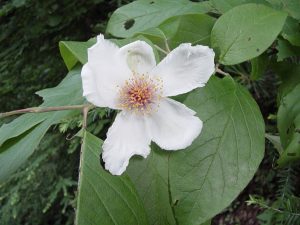
Please remember that picking plants is prohibited in Great Smoky Mountains National Park. Additionally, even some plants with traditional folk uses can have toxic properties if improperly prepared or used.

In this edition of Wildflowers 101, let’s look at two beautiful wildflowers that are not commonly found in Great Smoky Mountains National Park.
Woodland pinkroot has a vivid red bloom, and the inside of the trumpet is a bright yellow. The flowers appear in May and June, and the plant generally grows between 15 and 20 inches tall. Other names for the plant are Indian pink and wormgrass. As one would expect with the bright red blooms, the flowers are popular with hummingbirds.
The root of the plant produces strychnine and is said to have been used by Native Americans as a dewormer. One source says that European settlers in North America used extracts of the roots as a treatment for intestinal parasites.
It has been said that, when the plant was first discovered in Maryland in 1690, a botanist collected so much of it that it was never found again in that state.
The only trails where I have found woodland pinkroot flowers are Rich Mountain and Ace Gap. I have also seen them on Rich Mountain Road (Old Cades Cove Road outside the park).

The second wildflower we’ll examine in this article is the mountain camelia, which grows on deciduous shrubs or small trees up to 15 feet tall. From a distance, the bloom would remind you of a flowering dogwood. The plant is also called summer dogwood. The white blooms are about the same size as a dogwood bloom and appear in June and early July.
The only locations that I have found this wildflower are on Cooper Road Trail about three-tenths of a mile from Abrams Creek Campground, on Laurel Creek Road, and on the Metcalf Bottoms Trail approximately 20 feet from Wear Gap Road. My experience has been that the blooms deteriorate quickly after rainfall.
When you and I are out looking for and identifying wildflowers in the park, perhaps we can ponder the words of Miss Elsie Burrell about Great Smoky Mountains National Park who, after retiring from the Blount County School District, volunteered at the Little Greenbrier School near Metcalf Bottoms until she was 95 years old: “God’s beauty spot outdoors open for you and full of opportunities to learn.”
Most likely, many of you have found the words of Miss Elsie ring true. Hopefully, many more will avail themselves to capitalize on the amazing and enriching opportunities offered by and in this sanctuary. Happy wildflowering!
Tom Harrington is an Army veteran and retired insurance agent who has spent his life in Knox County, TN. He is an avid hiker and has volunteered for GSMNP since 2000.
Subscribe to get the latest posts sent to your email.
The Great Smokies Welcome Center is located on U.S. 321 in Townsend, TN, 2 miles from the west entrance to Great Smoky Mountains National Park. Visitors can get information about things to see and do in and around the national park and shop from a wide selection of books, gifts, and other Smokies merchandise. Daily, weekly, and annual parking tags for the national park are also available.